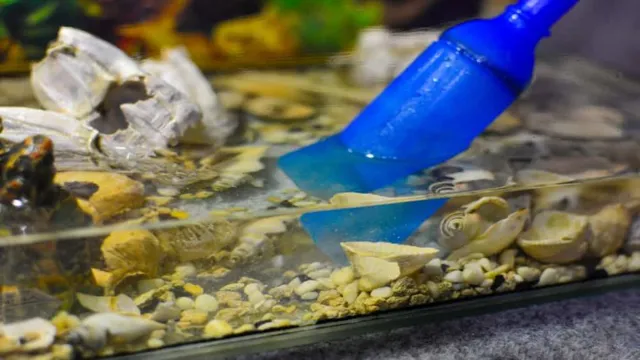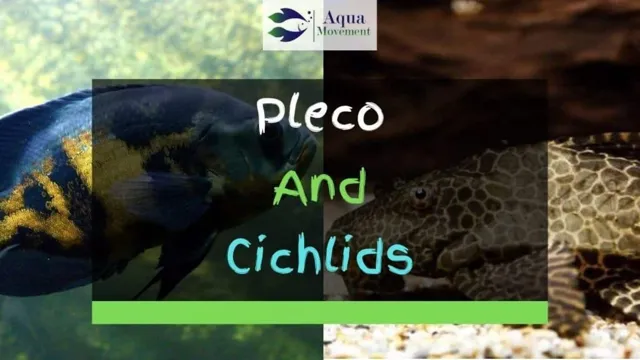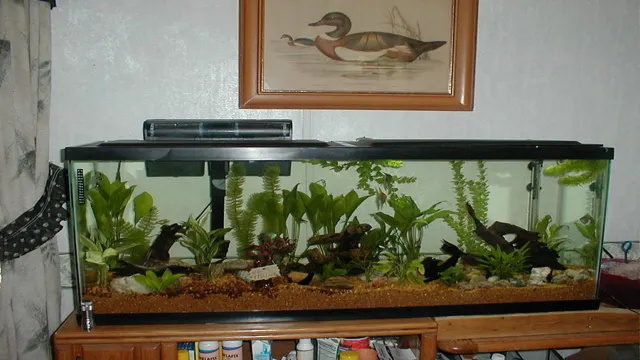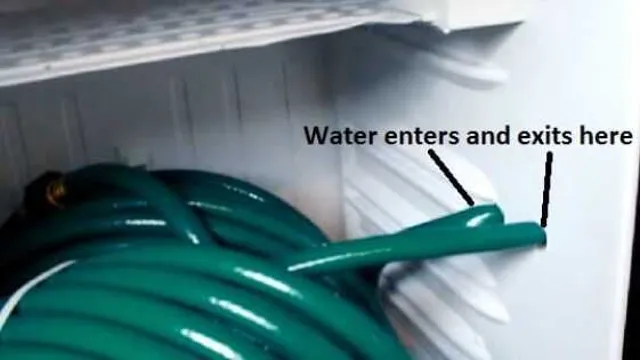Is Your Aquarium Infested with Blue-Green Algae? Here’s How to Get Rid of It. If you’re an aquarium owner, you’ve probably experienced the frustration of dealing with algae growth. Algae is a common problem in underwater environments, and blue-green algae, in particular, can be a major headache.
Not only does it ruin the aesthetic of your tank, but it can also harm your fish and other aquatic creatures. Thankfully, there are several ways to kill blue-green algae and prevent it from re-occurring in your aquarium. From manual removal to chemical treatments, we’re here to provide you with some tips and tricks to help you get your tank back to its former glory.
In this blog, we’ll cover the causes of blue-green algae, the dangers it poses to your aquarium inhabitants, and practical steps you can take to rid your tank of this frustrating algae. Whether you’re a seasoned aquarium owner or just starting, this guide will help you maintain a healthy and beautiful underwater environment for your aquatic pets. So, let’s get started!
What is Blue Green Algae?
Blue green algae, also known as cyanobacteria, are bacteria that can grow in both fresh and saltwater aquariums. They can be harmful to aquatic life, as they produce toxins that can damage fish and other organisms. If you’re wondering how to kill blue green algae in your aquarium, there are a few steps you can take.
First, remove any excess debris, such as uneaten fish food, from the tank. Next, reduce the amount of light the tank receives, as blue green algae thrive in bright light. You can also try using an algaecide designed specifically for cyanobacteria, but make sure to carefully follow the instructions and avoid overdosing.
Additionally, adding live plants to the tank can help compete with the blue green algae for nutrients, ultimately reducing their growth. Maintaining proper water parameters and performing regular water changes can also help prevent blue green algae from taking over your aquarium.
Definition and Characteristics
Blue Green Algae, also known as Cyanobacteria, are a diverse group of photosynthetic bacteria that live in freshwater, marine, and terrestrial environments. They are the oldest known organisms on Earth and play an essential role in the global carbon and nitrogen cycles. Blue Green Algae are characterized by their blue-green color and the ability to produce oxygen as a byproduct of photosynthesis.
They are also capable of fixing atmospheric nitrogen, which makes them important contributors to the nitrogen cycle. Blue Green Algae are unique in their ability to form colonies or filaments, which can range in size from single cells to massive mats. While most species of Blue Green Algae are harmless, some can produce toxins that are harmful to humans and animals.
Therefore, it is essential to distinguish between the different species before consuming or using them. The diversity and characteristics of Blue Green Algae make them fascinating organisms to study and understand.

How It Affects Your Aquarium
Blue green algae, also known as cyanobacteria, is an organism that can be found in both marine and freshwater environments. Although it is commonly referred to as algae, it is actually a type of bacteria that is capable of photosynthesis. Blue green algae can be harmful to your aquarium, as it can quickly grow and spread, resulting in potentially dangerous levels of toxins and oxygen depletion.
This can negatively impact the health of your fish and other aquatic creatures. To prevent the growth of blue green algae in your aquarium, it is important to properly maintain your tank and monitor nutrient levels. Regular water changes and proper filtration can also help prevent the growth of this harmful organism.
Prevention Measures
If you want to know how to kill blue green algae in your aquarium, then prevention is key. This type of algae thrives in nutrient-rich environments, so it’s essential to manage the water conditions of your tank properly. You can do this by conducting regular water changes to reduce waste buildup and add live plants. (See Also: How to Grow Duckweed in Aquarium: A Comprehensive Guide for Aquarists)
A well-planted aquarium helps to take up excess nutrients that feed algae growth. Proper lighting and circulation in your tank are also crucial to prevent stagnant water, where algae easily multiplies. If you notice signs of blue green algae growth, such as a slimy texture or an unpleasant odor, remove it immediately and consider adding an aquarium UV sterilizer.
These sterilizers use UV-C lights to kill any remaining algae spores in the water. Remember, prevention is always the first step in keeping your aquarium healthy and algae-free.
Maintain Optimal Water Parameters
Maintaining the optimal water parameters is crucial for the health and well-being of aquarium inhabitants. The best approach to keeping your aquarium healthy is through prevention measures. Ensure that you select the appropriate equipment and natural filtration systems to maintain the correct water conditions.
Be sure to monitor the water parameters frequently, so you can quickly respond to any variations that might arise. Additionally, adhere to a regular aquarium maintenance schedule to keep everything clean and well-maintained. By taking these preventative measures, you can avoid larger problems that require more substantial intervention later down the line.
Overall, the key to maintaining optimal water parameters is through prevention, and by prioritizing regular maintenance, you can ensure your aquatic pets thrive in a healthy environment.
Reduce Light and Nutrient Levels
Reducing light and nutrient levels is an effective prevention measure that gardeners should consider when dealing with plant diseases. High levels of light and nutrients can create an environment conducive for diseases to thrive, making it important to manage these conditions. By reducing light levels through pruning or shading, the growth and spread of disease-causing bacteria and fungi can be slowed down.
Additionally, reducing nutrient levels through proper fertilization can help prevent excessive growth, which can weaken and stress plants, making them more susceptible to diseases. It’s important to strike a balance when reducing light and nutrient levels, however, as reducing them too much can lead to weakened plants that are also more susceptible to diseases. By taking a preventative approach and adjusting light and nutrient levels, gardeners can reduce the likelihood of plant diseases and maintain healthy plants.
Frequent Water Changes and Gravel Vacuuming
Frequent water changes and gravel vacuuming are crucial preventive measures that promote the overall health and well-being of your aquarium inhabitants. By doing so, you can minimize the accumulation of harmful waste materials, excess food, and plant debris in your tank, which can compromise the water quality. For instance, partial water changes should be done at least once a week to remove uneaten food, dead plants, and fish waste.
Similarly, gravel vacuuming also helps to remove the debris that gets trapped in the substrate and layers of the aquarium. This process helps to prevent the buildup of nitrates and phosphates in the water, which can lead to the growth of harmful algae and bacteria. With regular cleaning and maintenance, you can create a healthy aquarium environment for your aquatic pets.
So, make sure you don’t underestimate the importance of frequent water changes and gravel vacuuming to keep your aquarium clean and healthy.
Treatment Options
If you’re wondering how to kill blue green algae in your aquarium, there are several treatment options available. One of the most effective ways is to use a commercial algaecide. This chemical treatment is designed to specifically target and kill algae, including blue-green algae.
However, it’s important to carefully follow the instructions on the label and not exceed the recommended dose, as it can be harmful to your fish and other aquatic life. Another option is to use natural remedies such as adding live plants, increasing water flow and aeration, performing regular water changes, and adjusting the lighting in the tank. These methods can help control and reduce the growth of algae over time, but may not completely eliminate it. (See Also: How to Make a Simple Water Filter for Aquarium: 5 Easy Steps to Cleaner Water)
Regardless of the treatment method chosen, consistent maintenance and monitoring of your aquarium is key to keeping it healthy and algae-free.
Manual Removal
When it comes to treating a skin infection like impetigo, manual removal is one option that doctors may recommend. This involves gently cleaning the infected area with warm water and soap and then using a cotton swab or gauze to carefully remove any crusted or scabbed-over areas. While this can be a bit uncomfortable, it can help to reduce the amount of bacteria present on the skin and promote faster healing.
Of course, this option may not be appropriate for everyone, especially those with particularly severe or widespread infections. It’s always best to speak with a healthcare professional who can recommend the best treatment option for your specific case. Ultimately, with proper care and attention, impetigo can be effectively treated and managed.
Chemical Treatment
Chemical treatment is a process that uses chemical agents to remove impurities and contaminants from various materials such as water, air, and soil. In the context of wastewater treatment, chemical treatment is often used in conjunction with physical and biological treatment methods. Chemical treatment can remove pollutants that are resistant to other methods.
The chemicals used in the treatment process can alter the pH levels, dissolve organic matter, or precipitate insoluble contaminants, thus making them easier to remove. Treatment options such as coagulation, flocculation, disinfection, and oxidation are some of the most common chemical treatment methods. Coagulation involves adding chemicals to cause suspended particles to stick together, forming larger particles that can be more easily removed.
Flocculation takes this process a step further, using the same chemicals to create larger “flocs” or clumps of particles that are even easier to remove. Disinfection involves the use of chemicals to kill harmful microorganisms in water. Oxidation involves the use of chemicals to break down organic matter into less harmful substances.
Chemical treatment is a highly effective method for removing contaminants from wastewater and providing environments that are safe for human or aquatic life.
Biological Control
Biological control is a method of pest management that involves using natural predators or parasites to control pest populations. This is often a more environmentally friendly option than chemical pesticides, as it doesn’t harm the surrounding ecosystem. One common example of biological control is the use of ladybugs to control aphids.
Ladybugs prey on aphids, which are a common pest in gardens and on crops. Another option for biological control is releasing parasitic wasps, which lay their eggs inside pest insects like caterpillars, eventually killing them. These treatment options require knowledge of the specific pest species involved and the natural predators or parasites available to control them.
If done correctly, biological control can be an effective and sustainable solution to pest control problems.
Conclusion
In conclusion, if you want to rid your aquarium of the pesky and unsightly blue green algae, the key is to attack it from multiple angles. Implement proper filtration and water flow, reduce the amount of light and nutrients available to the algae, and use chemical treatments sparingly and as directed. Remember, prevention is always the best cure, so monitor and maintain your aquarium regularly. (See Also: How to Get Potassium in My Aquarium: Easy Tips and Tricks)
With persistence and patience, you can banish blue green algae from your aquatic environment and enjoy a clear and healthy tank.”
FAQs
What is blue-green algae in an aquarium?
Blue-green algae are a type of bacteria that can grow in aquariums and form dense, unsightly mats on plant leaves, glass surfaces, and decorations.
How does blue-green algae affect an aquarium?
Blue-green algae can reduce oxygen levels in the water, harm fish and other aquatic life, and give the aquarium an unpleasant odor and appearance.
What causes blue-green algae in an aquarium?
Blue-green algae are caused by a combination of factors, including excess nutrients (such as too much nitrogen or phosphate), high light levels, and poor water circulation.
How do you prevent blue-green algae in an aquarium?
You can prevent blue-green algae by avoiding overfeeding, using a quality filtration system, reducing light exposure, removing any waste and debris from the aquarium, and performing regular water changes.
Can blue-green algae be removed by hand from an aquarium?
Yes, you can physically remove blue-green algae from an aquarium using a scrubber or a clean cloth. However, it is important to remove as much of the algae as possible to prevent it from growing back.
Are there any chemical treatments available to kill blue-green algae in an aquarium?
Yes, there are chemical treatments available to kill blue-green algae in an aquarium. However, it is important to read and follow the instructions carefully and use them as a last resort.
How long does it take to get rid of blue-green algae in an aquarium?
The time it takes to get rid of blue-green algae in an aquarium depends on the severity of the infestation and the treatment method used. It may take several weeks or even months to completely eliminate blue-green algae from an aquarium.







